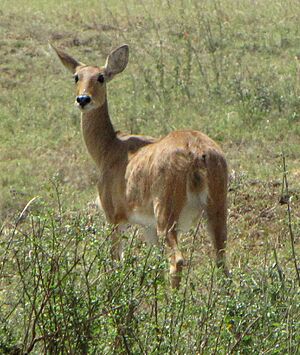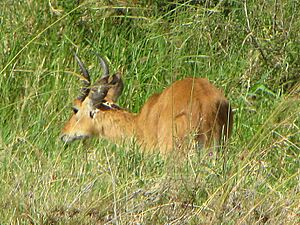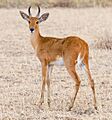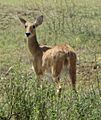Bohor reedbuck facts for kids
Quick facts for kids Bohor reedbuck |
|
|---|---|
 |
|
| Male bohor reedbuck in Serengeti, Tanzania | |
| Conservation status | |
| Scientific classification | |
| Subspecies | |
|
Subspecies list
R. r. bohor Rüppell, 1842
R. r. cottoni (W. Rothschild, 1902) R. r. nigeriensis (Blaine, 1913) R. r. redunca (Pallas, 1767) R. r. wardi (Thomas, 1900) |
|
| Synonyms | |
The bohor reedbuck (Redunca redunca) is a type of antelope that lives in central Africa. These medium-sized animals are part of the Redunca group and the Bovidae family, which includes cattle and goats. A German scientist named Peter Simon Pallas first described them in 1767. There are five different kinds, or subspecies, of the bohor reedbuck.
Bohor reedbucks are usually between 100–135 cm (39–53 in) long from head to body. Males are taller, standing about 75–89 cm (30–35 in) at the shoulder. Females are a bit smaller, around 69–76 cm (27–30 in) tall. Males weigh more, typically 43–65 kg (95–143 lb), while females weigh 35–45 kg (77–99 lb). They have a strong build and a coat that can be yellow to grayish-brown. Only the male bohor reedbucks have horns, which are about 25–35 cm (9.8–13.8 in) long.
These antelopes eat plants, mostly grasses and soft reed shoots. They need water, but can get enough from green plants if available. Their social groups can change a lot. During the dry season, many bohor reedbucks gather near rivers. Males are ready to have babies at three to four years old. Females can start having babies at just one year old, giving birth every nine to fourteen months. They don't have a specific breeding season, but most mating happens during the rainy season. A single calf is born after about seven and a half months. Calves stop drinking their mother's milk when they are eight to nine months old.
Bohor reedbucks live in wet grasslands, swamps, and woodlands. They are found in many African countries, from Benin to Uganda. Sadly, they might be gone from Ivory Coast. Hunting and losing their homes due to human settlements have made their numbers drop. However, they tend to survive better in these changed areas compared to other similar animals. There are over 100,000 bohor reedbucks left. More of them live in eastern and central Africa than in western Africa. The International Union for Conservation of Nature (IUCN) says the bohor reedbuck is of least concern, meaning it's not currently in danger of disappearing.
Contents
Understanding the Bohor Reedbuck
The bohor reedbuck is a fascinating animal. Let's learn more about its scientific classification and how it looks.
What is a Bohor Reedbuck?
The scientific name for the bohor reedbuck is Redunca redunca. It belongs to the Redunca group and the Bovidae family. This family includes many well-known animals like cows, goats, and sheep. The bohor reedbuck was first described by a German scientist named Peter Simon Pallas in 1767.
There are five different kinds, or subspecies, of the bohor reedbuck:
- R. r. bohor: Also called the Abyssinian bohor reedbuck. It lives in parts of Ethiopia and Sudan.
- R. r. cottoni: Found in southern Sudan, northeastern Democratic Republic of the Congo, and possibly northern Uganda.
- R. r. nigeriensis: This type lives in Nigeria, northern Cameroon, southern Chad, and the Central African Republic.
- R. r. redunca: Its home stretches from Senegal east to Togo. It lives in the northern savannas of Africa.
- R. r. wardi: Found in Uganda, eastern Democratic Republic of the Congo, and eastern Africa.
How Do Bohor Reedbucks Look?
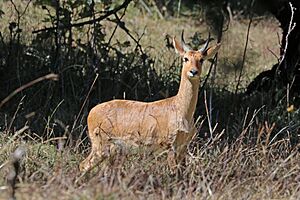
The bohor reedbuck is a medium-sized antelope. From head to body, they are usually between 100–135 cm (39–53 in) long. Males are taller, standing about 75–89 cm (30–35 in) at the shoulder. Females are a bit shorter, around 69–76 cm (27–30 in) tall. Males are also heavier, typically weighing 43–65 kg (95–143 lb), while females weigh 35–45 kg (77–99 lb). Their bushy tail is about 18–20 cm (7.1–7.9 in) long. Males are generally 10% to 20% larger than females and have clearer markings.
The bohor reedbuck has a strong body and a coat that ranges from yellow to grayish-brown. They are usually yellower than other types of reedbucks. Their coat feels greasy and has a strong smell because of special glands. Young bohor reedbucks are darker and have longer hair than adults. Their bellies are white. They have some distinct markings, like a dark stripe on the front of each front leg. They also have white markings under their tail and a pale ring of hair around their eyes, lips, lower jaw, and upper throat. However, the R. r. redunca subspecies does not have dark stripes on its front legs. Males have thicker necks. Their large, oval-shaped ears help tell them apart from other antelopes. They also have a bare spot below each ear. Bohor reedbucks can live for at least ten years.
Male Horns
Only male bohor reedbucks have horns. These horns are short and strong, growing backward from the forehead and then curving slightly forward. They are about 25–35 cm (9.8–13.8 in) long. Some bohor reedbucks in Senegal have longer, wider horns. Compared to other reedbuck species, the bohor reedbuck has the shortest and most hooked horns. The longest horns are found on the R. r. cottoni subspecies, which are less hooked and may curve inward. The R. r. bohor subspecies has short, strong horns that point forward. The length of their horns can sometimes depend on how many other reedbucks live in that area. For example, reedbucks in eastern Africa, where populations are spread out, have shorter horns. Those in the Nile valley, where many reedbucks live close together, have longer, wider horns.
Life and Habits of the Bohor Reedbuck
Bohor reedbucks are active throughout the day. They often look for cover during the day and eat grass at night. They spend a lot of their time eating and watching for danger.
Staying Safe from Predators
Bohor reedbucks are good at hiding in tall grasses and reeds. Instead of running away from danger, they often stay still or slowly move into cover. If a threat gets too close, they will run, making a loud, high-pitched whistle to warn others. They hide from predators rather than forming large groups for defense. Many animals hunt bohor reedbucks, including lions, cheetahs, leopards, hyenas, wild dogs, and crocodiles.
Social Life and Territory
If there is enough shade, female bohor reedbucks often stay alone. Otherwise, they might gather with their young in groups of up to ten animals. A female's home range is about 15–40 hectares (37–99 acres; 0.058–0.154 sq mi). Males have larger territories, covering 25–60 hectares (62–148 acres; 0.097–0.232 sq mi). These areas often overlap. As young females grow up, they move away from their mothers' home ranges. Male bohor reedbucks are quite tolerant. They might even let up to 19 other bachelor males stay in their territory if there are no females around. A male's territory can have as many as five females. When young males start growing horns (around one and a half years old), the adult males will chase them away. These young males then form small groups of two or three on the edges of territories until they are old enough to have their own (around four years old). During the dry season, hundreds of bohor reedbucks can gather near a river.
Communication and Fights
Bohor reedbucks communicate by whistling and bounding. Instead of marking their territory with scent, they use a loud whistle to show where their territory ends. When they whistle, they push air through their nose so strongly that their whole body vibrates. These whistles, usually one to three of them, are followed by a few bouncy jumps. This behavior is also used to warn others in a group about danger. When doing this, the reedbuck raises its neck, showing the white patch on its throat, but keeps its tail down. It leaps like an impala, landing on its front legs. This is also when special glands in their legs make a popping sound. Fights between males start with both animals holding their horns low, ready to fight. Then they lock horns and push each other. These fights can sometimes be very serious and even lead to death.
What Do Bohor Reedbucks Eat?
Bohor reedbucks are herbivores, meaning they eat plants. They prefer grasses and soft reed shoots that are high in protein and low in fiber. They need water, but can get enough from green plants if available. A study in Rwenzori Mountains National Park in Uganda showed that they especially liked a grass called Sporobolus consimilis. Other grasses they eat include Hyparrhenia filipendula, Heteropogon contortus, and Themeda triandra. These are common grasses in areas where many animals graze. In the wet season, they prefer Cynodon dactylon and Cenchrus ciliaris. In the dry season, they switch to Sporobolus pyramidalis and Panicum repens. They rarely eat other types of plants, but sometimes they might eat Capparis and Sida species. In areas where fires happen often, they eat Imperata species. Near water, they eat Leersia and new Vossia shoots.
Bohor reedbucks mostly eat at night, but they can also graze during the day. Studies show they eat most at dawn and late afternoon. At night, they have two more eating times: at dusk and midnight. They travel far from their hiding spots during the day to find food. How much time they spend grazing in an area changes with the seasons, depending on how much good grass is available. Bohor reedbucks often graze with other plant-eating animals like hartebeest, topi, puku, and kob. In farmlands in Kenya, they might eat growing wheat and other grains.
How Bohor Reedbucks Reproduce
Male bohor reedbucks are ready to have babies when they are three to four years old. Females can start having babies at just one year old. They can have a new baby every nine to fourteen months. There isn't a specific time of year when they breed, but most mating happens during the rainy season. Males fight for dominance in special "assembly fields." Up to 40 males might gather in an area of 1 hectare (2.5 acres; 0.0039 sq mi). Some parts of these fields are very popular, marked with dung and urine.
The mother carries the baby for about seven and a half months. After this, a single calf is born. Mothers keep their babies hidden for up to eight weeks. The mother stays about 20–30 m (66–98 ft) away from her calf. When nursing, which lasts two to four minutes, the mother licks the calf's whole body. The baby usually drinks milk once during the day and one to two times at night. The mother's older calf might not want to be separated from her. At two months old, the calf starts eating grass with its mother. It will also seek protection from her if it feels scared. After four months, the mother stops licking the calf, but she might still groom it. Calves stop drinking their mother's milk when they are eight to nine months old.
Where Bohor Reedbucks Live
Bohor reedbucks live in wet grasslands, swamps, and woodlands. In northern Cameroon, they are found in two types of places: grasslands that flood seasonally, rich in grasses like Vetiveria nigritana and Echinochloa pyramidalis, and Isoberlina woodlands. Bohor reedbucks are often found in grasslands that can have floods and droughts. They are very good at adapting to big seasonal changes and natural disasters. They are not as widespread as the bushbuck because they need specific types of habitats. In some areas, the bohor reedbuck shares its home with the mountain reedbuck. The areas where bohor reedbucks and southern reedbucks live overlap a lot in Tanzania.
Bohor reedbucks are only found in Africa. They live in Benin, Burkina Faso, Burundi, Cameroon, Central African Republic, Chad, Democratic Republic of the Congo, Ethiopia, the Gambia, Ghana, Guinea, Guinea-Bissau, Kenya, Mali, Mauritania, Niger, Nigeria, Rwanda, Senegal, Sudan, Tanzania, and Togo. They might be gone from Ivory Coast and Uganda. They used to be found across western, central, and eastern Africa. Now, their range goes from Senegal in the west to Ethiopia in the east. Among the three reedbuck species, the bohor reedbuck is the most widespread in Tanzania. Their status in Burundi, Eritrea, Ghana, and Togo is not clear. They are rare in Niger and Nigeria.
Dangers and Protection for Bohor Reedbucks
Hunting without limits and losing their homes because of human settlements have caused a big drop in the number of bohor reedbucks. However, these antelopes tend to survive longer in these changed areas compared to their relatives. Natural disasters, like droughts, are also major threats. In northern Cameroon, their numbers have gone down because floodplains have been damaged by building dams. In Chad and Tanzania, their homes have been destroyed by farming and new settlements. Many bohor reedbucks also die from being hit by cars or drowning. During the dry season in Uganda, people hunt bohor reedbucks with dogs and nets. Hunters especially value reedbucks with the largest horns.
There are an estimated 100,000 bohor reedbucks left. Even though their numbers are decreasing, they are not low enough to be considered "near threatened." Because of this, the IUCN rates the bohor reedbuck as of least concern. About three-quarters of the bohor reedbuck population lives in protected areas. Their numbers are either going down or are uncertain in places like Boucle du Baoulé National Park (Mali), Comoé National Park (Ivory Coast), and Mole and Digya national parks (Ghana). In Akagera National Park, where the last known bohor reedbucks in Rwanda live, their numbers have fallen sharply.
Even though their populations have decreased a lot in western Africa, bohor reedbucks still live in Niokolo-Koba National Park (Senegal), Corubal River (Guinea-Bissau), Kiang West National Park (Gambia), and Arly-Singou and Nazinga Game Ranch (Burkina Faso). Larger numbers are found in eastern and central Africa, mostly in protected areas. These include Bouba Ndjida (Cameroon), Manovo-Gounda St. Floris National Park (Central African Republic), Bale Mountains National Park (Ethiopia), Murchison Falls National Park and Pian Upe Wildlife Reserve (Uganda), Maasai Mara (Kenya), Serengeti National Park, Moyowosi-Kigosi, and Selous Game Reserve (Tanzania).
Images for kids
-
Male R. r. bohor, Ethiopia



